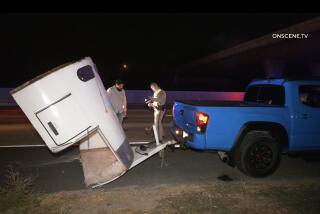Land purchase makes possible big-cat crossing over — or under — I-15 in Riverside County
Reporting from San Diego — Mountain lions that roam two Southern California mountain ranges separated by a freeway are the impetus for a recent land purchase — the first step toward creating a wildlife crossing to enable the pumas to mingle and breed.
The Nature Conservancy has purchased a 73-acre property adjacent to the eastern side of Interstate 15 just north of the Riverside County line. On the other side of the freeway is an ecological preserve. The goal is to build a tunnel beneath or a bridge across the heavily traveled freeway to connect the Santa Ana and Palomar mountains.
The wildlife crossing would be built primarily for the benefit of the fewer than 30 lions that live in the Santa Ana range, which extends for 61 miles along the border of Orange and Riverside counties.
“Without it, the mountain lion population in the Santa Ana Mountains, which is already severely inbred, could disappear in the next 50 years,” said Cara Lacey, associate program director at the Nature Conservancy.
Lions from the Palomar range, which experts believe may number in the hundreds and are healthier than those in the Santa Anas, would be able to interact and mate with the Santa Ana lions on both sides of the freeway after the crossing is constructed.
The Nature Conservancy paid $1.69 million for the land, which it bought from several investors. There are plans to buy other land in the area to widen the wildlife linkage.
On the west side of the freeway is the Santa Margarita Ecological Reserve, which is managed by San Diego State.
“There are preserves on both sides now,” Lacey said. “That’s why it was such a key property.”
In 2015, the Nature Conservancy convened wildlife connectivity experts from across the United States to evaluate 11 potential wildlife crossing points along I-15 south of Temecula. The Rainbow Canyon property ranked as the highest-priority location for a crossing because of its potential to house the most functional crossing for the widest array of wildlife and plant species, according to a study the group released.
A genetic analysis of 146 sampled pumas, the study said, indicates that just seven pumas managed to cross I-15 over the last 15 years, including four males from west to east and three males from east to west.
“Urban and rural development remain a threat to what remains of the linkage, and I-15 and associated development, as well as secondary roads, have formed an apparent partial or complete barrier to east/west movement for wildlife and plants,” the study concluded.
Though mountain lions are the primary reason that conservationists seek a crossing, a wildlife bridge or tunnel would allow a variety of animal species to cross the freeway.
“From mountain lions all the way down to frogs,” Lacey said, “raccoons, deer and also plants.”
The conservancy will work with multiple partners to determine whether a tunnel, a bridge or perhaps even both will work best for the site. Funding for the crossing, which will cost many millions of dollars, is yet to be found.
Lacey said it will probably be years before a crossing is a reality. Public workshops will be held next year as part of the process.
“This purchase opens the possibility of a future wildlife crossing above or below the highway to enable a future system of crossings and allow safe passage for wildlife,” Lacey said, “removing the need for them to make the dangerous scramble across traffic, while also improving safety for people.”
Jones writes for the San Diego Union-Tribune.
More to Read
Sign up for Essential California
The most important California stories and recommendations in your inbox every morning.
You may occasionally receive promotional content from the Los Angeles Times.










